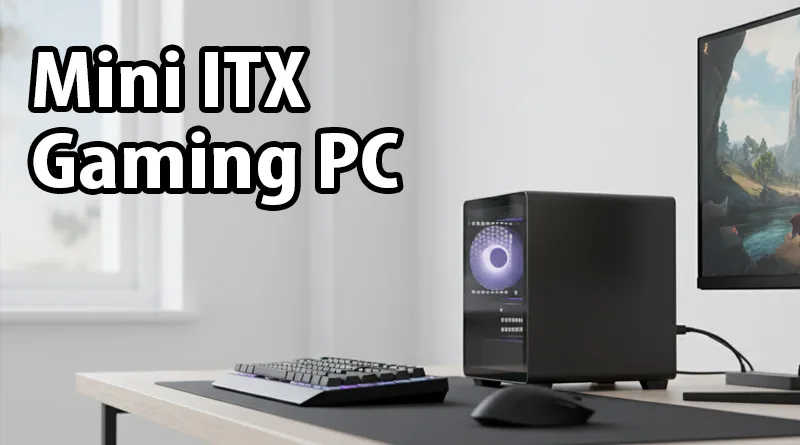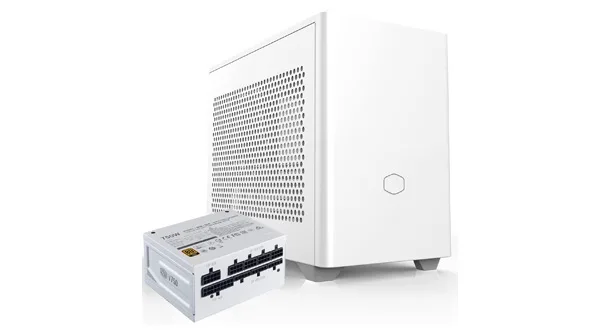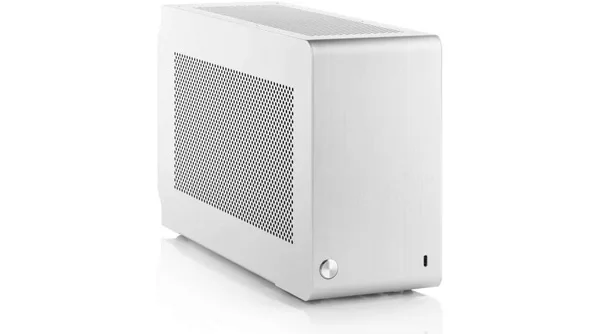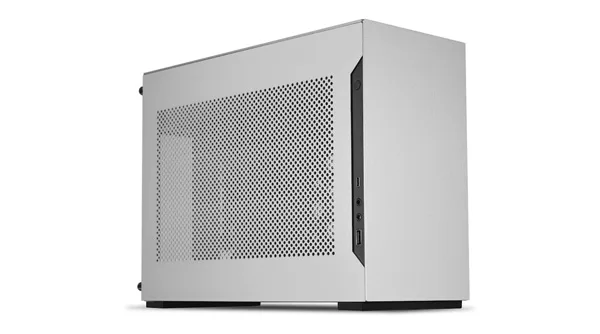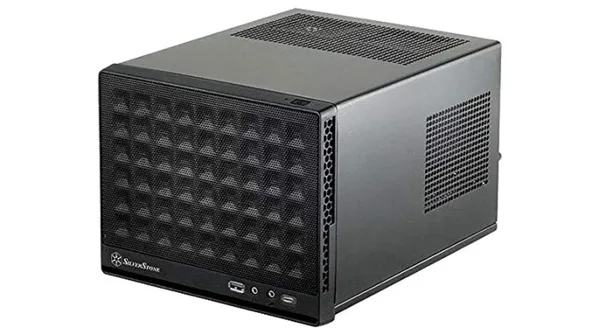The era of the massive, tower-sized gaming PC is giving way to the compact powerhouse. The Mini ITX Gaming PC has emerged as the definitive choice for gamers who prioritize desk space, portability, and clean aesthetics without sacrificing an ounce of performance. These Small Form Factor (SFF) builds pack the highest-end CPUs and GPUs into cases the size of a shoebox.
Building a Mini ITX Gaming PC is more challenging than a standard build, requiring careful selection of components to manage space, power, and, most critically, heat. This ultimate guide breaks down the best cases, the must-have components, and the common pitfalls to avoid to help you build a tiny, but mighty, gaming machine.
What is a Mini ITX Gaming PC and Why Choose It?
The Mini ITX Gaming PC is defined by its motherboard size: 6.7 inches by 6.7 inches. This dictates the incredibly compact nature of the entire build.
Core Advantages of Mini ITX
- Portability: Easy to transport to LAN parties, friends’ houses, or move between rooms.
- Aesthetics: A much cleaner, less imposing look that fits better into modern, minimalist setups.
- Space Saving: Takes up a fraction of the desk space of a traditional mid-tower or full-tower case.
The Trade-Offs (The Challenges)
- Price: Mini ITX motherboards and SFF cases carry a price premium.
- Cooling: Cramming powerful, hot components into a small space makes thermal management difficult and requires liquid cooling or specialized coolers.
- Building Difficulty: The tight space makes cable management and component installation much more tedious.
The Components: How Mini ITX Dictates Your Build
When building a Mini ITX Gaming PC, every component choice is a puzzle piece dictated by the small form factor.
1. The Motherboard (Mini ITX)
- Size Restriction: You are limited to two RAM slots and typically only one full-sized PCIe slot (for the GPU).
- Feature Focus: Because of the tight space, look for motherboards with built-in Wi-Fi and ample M.2 slots (eliminating the need for SATA drives and cables).
2. The Case (The SFF Chassis)
The case is the most important decision. Cases are defined by GPU clearance and cooling capacity.
- Shoebox/Console Style: Cases like the Fractal Design Node 202 or Silverstone RVZ03 are very small and often use a riser cable to mount the GPU parallel to the motherboard.
- Tower/Cube Style: Cases like the Cooler Master NR200 or NZXT H1 are slightly larger but allow for traditional tower air coolers and better airflow.
3. The GPU (The Length Barrier)
- You must strictly check the case’s maximum supported GPU length. Many powerful cards (e.g., RTX 4090) are too long for the most compact Mini ITX cases. Prioritize blower-style cards or two-slot designs where possible.
4. The Power Supply (PSU)
- SFX Form Factor: Most SFF cases require an SFX (Small Form Factor) PSU, which is much smaller than the standard ATX PSU. These are more expensive but are non-negotiable for most compact cases.
Top 5 Mini ITX Cases for a Gaming PC (2025 Picks)
The case dictates the entire build experience. Here are the five best options based on balancing size, cooling, and hardware support.
1. Best Overall (Ease of Build): Cooler Master NR200P
- Pros: Excellent thermal performance, great compatibility with large air coolers, and easy to work inside. Comes with a vertical GPU bracket.
- Cons: Slightly larger than the most compact options.
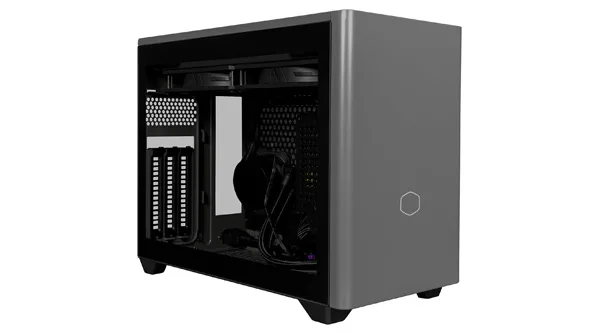
2. Best Value for Airflow: Cooler Master MasterBox NR200
- Pros: The standard version of the NR200P but without the glass panel, offering a slightly better price and superior ventilation via a mesh panel.
- Cons: Requires separate purchase of fans if needed.
3. Best Ultra-Compact & Premium: DAN A4-SFX V4.1 (or similar high-end SFF)
- Pros: One of the absolute smallest PC cases available, designed for high-performance components in a console-like footprint. A true premium SFF option.
- Cons: Extremely difficult to build in; requires a specialized Mini ITX Gaming PC liquid cooler setup.
4. Best Water Cooling Option: Lian Li A4-H20
- Pros: Designed specifically for liquid cooling, one of the smallest cases that can fit a 240mm AIO cooler.
- Cons: Very challenging build for beginners.
5. Best Budget Pick: Silverstone Sugo SG13
- Pros: Low price, can surprisingly fit a full-sized ATX PSU (though SFX is recommended).
- Cons: Dated design, very poor cable management.
Thermal Management: The Biggest Mini ITX Challenge
The primary reason a Mini ITX Gaming PC fails to perform is due to heat. A tightly packed space means components recirculate their own hot air, leading to CPU and GPU throttling.
Cooling Rules for Mini ITX:
- AIO is King: A 240mm or 280mm AIO (All-in-One Liquid Cooler) is highly recommended for CPUs over 65W TDP. It removes heat directly from the case.
- Low-Profile Coolers: If you must use air cooling, specialized low-profile coolers (like the Noctua NH-L9i) are required.
- Positive Pressure: Configure your fans to push more air into the case (intake) than out (exhaust). This creates positive pressure, which helps push hot air out of un-fanned vents and keeps dust out.
Pre-Built Mini PCs and the SFF Market
Not every compact PC is a custom build. Several manufacturers offer tiny pre-built PCs that use similar SFF principles, capturing users who don’t want the hassle of building.
f you are considering a compact, pre-built option that skips the ITX assembly, compare the top offerings in our guide: Lenovo Mini PC Review: The Best Small Form Factor Desktops for Gaming.
Alternatively, for a different brand-specific view on the market, check out our dedicated analysis of the most popular compact desktops: Dell Mini PC Review: The Small Form Factor Desktops That Can Game.
Mini ITX vs. Micro-ATX: The Sizing Dilemma
The final question for compact builders is often whether to go with the absolute smallest (Mini ITX) or the slightly larger, more builder-friendly Micro-ATX.
- Micro-ATX Advantage: Micro-ATX boards are cheaper, have four RAM slots, and offer two PCIe slots (allowing for capture cards or extra storage). Cases are easier to build in.
- Mini ITX Advantage: Absolute smallest size possible.
For a direct comparison of the two sizes and their component trade-offs, read our full guide: Mini ITX Gaming PC vs. Micro ATX Gaming PC: Which Small Form Factor is Right For You?
Conclusion: The Tiny Performance Giant
The Mini ITX Gaming PC is no longer a niche, compromised option—it is a performance class that can rival any full-sized desktop. The key to a successful build lies in patience, a great SFF case, and a deliberate focus on cooling.
If you value a clean aesthetic and a minimal footprint, the challenge of the Mini ITX build is well worth the reward. Start your journey by selecting one of our top-rated cases, and remember to always check component clearance before you buy.

